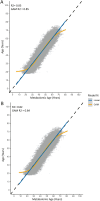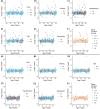Robust Metabolomic Age Prediction Based on a Wide Selection of Metabolites
- PMID: 39821408
- PMCID: PMC11809259
- DOI: 10.1093/gerona/glae280
Robust Metabolomic Age Prediction Based on a Wide Selection of Metabolites
Abstract
Chronological age is a major risk factor for numerous diseases. However, chronological age does not capture the complex biological aging process. The difference between chronological age and biologically driven aging could be more informative in reflecting health status. Here, we set out to develop a metabolomic age prediction model by applying ridge regression and bootstrapping with 826 metabolites (678 endogenous and 148 xenobiotics) measured by an untargeted platform in relatively healthy blood donors aged 18-75 years from the INTERVAL study (N = 11 977; 50.2% men). After bootstrapping internal validation, the metabolomic age prediction models demonstrated high performance with an adjusted R2 of 0.83 using all metabolites and 0.82 using only endogenous metabolites. The former was significantly associated with obesity and cardiovascular disease in the Netherlands Epidemiology of Obesity study (N = 599; 47.0% men; age range = 45-65) due to the contribution of medication-derived metabolites-namely salicylate and ibuprofen-and environmental exposures such as cotinine. Additional metabolomic age prediction models using all metabolites were developed for men and women separately. The models had high performance (R² = 0.85 and 0.86) but shared a moderate correlation of 0.72. Furthermore, we observed 163 sex-dimorphic metabolites, including threonine, glycine, cholesterol, and androgenic and progesterone-related metabolites. Our strongest predictors across all models were novel and included hydroxyasparagine (Model Endo + Xeno β = 4.74), vanillylmandelate (β = 4.07), and 5,6-dihydrouridine (β = -4.2). Our study presents a robust metabolomic age model that reveals distinct sex-based age-related metabolic patterns and illustrates the value of including xenobiotic to enhance metabolomic prediction accuracy.
Keywords: Cardiovascular disease; Metabolomic age; Metabolomics; Obesity; Prediction model.
© The Author(s) 2025. Published by Oxford University Press on behalf of the Gerontological Society of America.
Conflict of interest statement
P.S. is an associate director of applied and statistical genetics at GlaxoSmithKline plc. A.S.B. reports institutional grants from AstraZeneca, Bayer, Biogen, BioMarin, Bioverativ, Novartis, Regeneron, and Sanofi. The other authors have no conflicts of interest to declare.
Figures



Similar articles
-
NMR metabolomic modeling of age and lifespan: A multicohort analysis.Aging Cell. 2024 Jul;23(7):e14164. doi: 10.1111/acel.14164. Epub 2024 Apr 18. Aging Cell. 2024. PMID: 38637937 Free PMC article.
-
Metabolomics data improve 10-year cardiovascular risk prediction with the SCORE2 algorithm for the general population without cardiovascular disease or diabetes.Eur J Prev Cardiol. 2025 Apr 24:zwaf254. doi: 10.1093/eurjpc/zwaf254. Online ahead of print. Eur J Prev Cardiol. 2025. PMID: 40269530
-
Past or Present; Which Exposures Predict Metabolomic Aging Better? The Doetinchem Cohort Study.J Gerontol A Biol Sci Med Sci. 2024 Feb 1;79(2):glad202. doi: 10.1093/gerona/glad202. J Gerontol A Biol Sci Med Sci. 2024. PMID: 37642222 Free PMC article.
-
An epidemiological introduction to human metabolomic investigations.Trends Endocrinol Metab. 2023 Sep;34(9):505-525. doi: 10.1016/j.tem.2023.06.006. Epub 2023 Jul 17. Trends Endocrinol Metab. 2023. PMID: 37468430 Free PMC article. Review.
-
Metabolomic epidemiology offers insights into disease aetiology.Nat Metab. 2023 Oct;5(10):1656-1672. doi: 10.1038/s42255-023-00903-x. Epub 2023 Oct 23. Nat Metab. 2023. PMID: 37872285 Free PMC article. Review.
Cited by
-
Accelerated Metabolomic Aging and Its Association with Social Determinants of Health in Multiple Sclerosis.medRxiv [Preprint]. 2025 May 5:2025.01.29.25321260. doi: 10.1101/2025.01.29.25321260. medRxiv. 2025. PMID: 39974014 Free PMC article. Preprint.
References
-
- North BJ, Sinclair DA. The intersection between aging and cardiovascular disease. Circ Res. 2012;110(8):1097–1108. https://doi.org/ 10.1161/CIRCRESAHA.111.246876 - DOI - PMC - PubMed
-
- Broglio SP, Eckner JT, Paulson HL, Kutcher JS. Cognitive decline and aging: the role of concussive and subconcussive impacts. Exerc Sport Sci Rev. 2012;40(3):138–144. https://doi.org/ 10.1097/JES.0b013e3182524273 - DOI - PMC - PubMed
-
- Lopez-Otin C, Blasco MA, Partridge L, Serrano M, Kroemer G. The hallmarks of aging. Cell. 2013;153(6):1194–1217. https://doi.org/ 10.1016/j.cell.2013.05.039 - DOI - PMC - PubMed
-
- Hoffman JM, Lyu Y, Pletcher SD, Promislow DEL. Proteomics and metabolomics in ageing research: from biomarkers to systems biology. Essays Biochem. 2017;61(3):379–388. https://doi.org/ 10.1042/EBC20160083 - DOI - PMC - PubMed
-
- Brooks-Wilson AR. Genetics of healthy aging and longevity. Hum Genet. 2013;132(12):1323–1338. https://doi.org/ 10.1007/s00439-013-1342-z - DOI - PMC - PubMed
MeSH terms
Grants and funding
LinkOut - more resources
Full Text Sources
Medical

